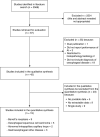Systematic review with meta-analysis: artificial intelligence in the diagnosis of oesophageal diseases
- PMID: 35098562
- PMCID: PMC9305819
- DOI: 10.1111/apt.16778
Systematic review with meta-analysis: artificial intelligence in the diagnosis of oesophageal diseases
Erratum in
-
Corrigendum.Aliment Pharmacol Ther. 2022 Sep;56(5):928. doi: 10.1111/apt.17166. Aliment Pharmacol Ther. 2022. PMID: 35934865 Free PMC article. No abstract available.
Abstract
Background: Artificial intelligence (AI) has recently been applied to endoscopy and questionnaires for the evaluation of oesophageal diseases (ODs).
Aim: We performed a systematic review with meta-analysis to evaluate the performance of AI in the diagnosis of malignant and benign OD.
Methods: We searched MEDLINE, EMBASE, EMBASE Classic and the Cochrane Library. A bivariate random-effect model was used to calculate pooled diagnostic efficacy of AI models and endoscopists. The reference tests were histology for neoplasms and the clinical and instrumental diagnosis for gastro-oesophageal reflux disease (GERD). The pooled area under the summary receiver operating characteristic (AUROC), sensitivity, specificity, positive and negative likelihood ratio (PLR and NLR) and diagnostic odds ratio (DOR) were estimated.
Results: For the diagnosis of Barrett's neoplasia, AI had AUROC of 0.90, sensitivity 0.89, specificity 0.86, PLR 6.50, NLR 0.13 and DOR 50.53. AI models' performance was comparable with that of endoscopists (P = 0.35). For the diagnosis of oesophageal squamous cell carcinoma, the AUROC, sensitivity, specificity, PLR, NLR and DOR were 0.97, 0.95, 0.92, 12.65, 0.05 and DOR 258.36, respectively. In this task, AI performed better than endoscopists although without statistically significant differences. In the detection of abnormal intrapapillary capillary loops, the performance of AI was: AUROC 0.98, sensitivity 0.94, specificity 0.94, PLR 14.75, NLR 0.07 and DOR 225.83. For the diagnosis of GERD based on questionnaires, the AUROC, sensitivity, specificity, PLR, NLR and DOR were 0.99, 0.97, 0.97, 38.26, 0.03 and 1159.6, respectively.
Conclusions: AI demonstrated high performance in the clinical and endoscopic diagnosis of OD.
Keywords: Barrett’s oesophagus; IPCL; artificial intelligence; gastroesophageal reflux disease; gastrointestinal endoscopy; oesophageal cancer.
© 2022 The Authors. Alimentary Pharmacology & Therapeutics published by John Wiley & Sons Ltd.
Figures




References
-
- Le Berre C, Sandborn WJ, Aridhi S, et al. Application of artificial intelligence to gastroenterology and hepatology. Gastroenterology. 2020;158:76‐94.e2. - PubMed
-
- Sana MK, Hussain ZM, Shah PA, Maqsood MH. Artificial intelligence in celiac disease. Comput Biol Med. 2020;125:103996. - PubMed
-
- Hassan C, Spadaccini M, Iannone A, et al. Performance of artificial intelligence in colonoscopy for adenoma and polyp detection: a systematic review and meta‐analysis. Gastrointest Endosc. 2021;93:77‐85.e6. - PubMed
-
- Barua I, Vinsard DG, Jodal HC, et al. Artificial intelligence for polyp detection during colonoscopy: a systematic review and meta‐analysis. Endoscopy. 2021;53:277‐284. - PubMed
Publication types
MeSH terms
LinkOut - more resources
Full Text Sources
Medical
